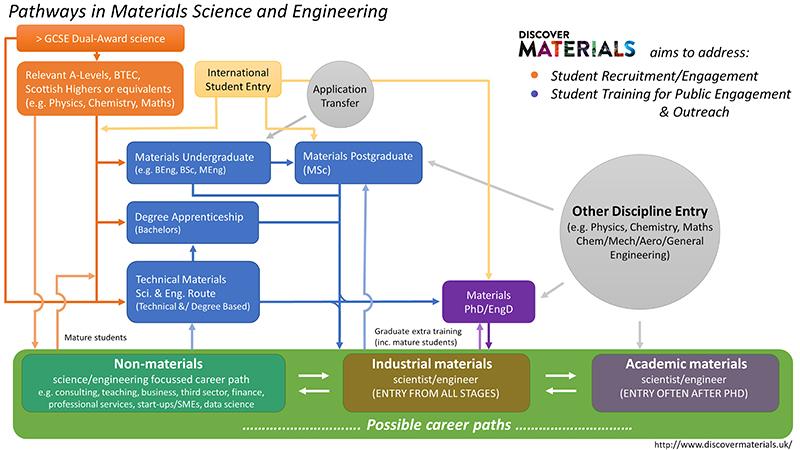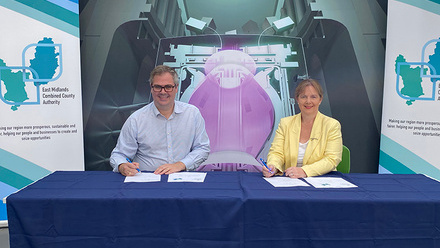Developing a materials world – why (not) us?
In the first of a series of articles, the team behind the UK’s collaborative Discover Materials initiative explores the university application journey and prospective student population to understand issues surrounding recruitment into materials science and engineering in the UK.

This article was written by: Dr Eleonora D’Elia, Strategic Teaching Fellow, Imperial College London; Professor Alessandro Mottura FIMMM, Professor of Physical Metallurgy, University of Birmingham; Professor Ben Britton FIMMM, Associate Professor, University of British Columbia and Visiting Reader, Imperial College London; Dr Han Zhang MIMMM, Lecturer in Materials Science, Queen Mary University of London; Dr Chris Hamlett, Henry Royce National Outreach Officer for Materials Science and Engineering, Discover Materials and University of Birmingham.
Although humankind has been exploiting materials for millennia, Materials Science and Engineering (MSE) only started to possess its own disciplinary identity in the 1970s when the Materials Research Society (MRS) was first founded in parallel with the founding of the UK's first university Materials Departments.
Previously, the fields of study and research around materials were extremely fragmented, ranging from ceramics and glass, metallurgy, polymers and textiles, and more. Since then, MSE has grown into a field that is taking over the world and the hearts of many, by demonstrating the breadth of its reach and uses, and its multidisciplinary nature.
Many books have been published and research facilities and funding bodies have been created to include this subject. Cutting-edge research is shaped through investment in national and international facilities, which have provided new insights into the structure and performance of materials across length scales.
This includes many UK-based, state-of-the-art facilities, such as Diamond Light Source, the ISIS neutron source, advanced electron microscopy (e.g. SuperSTEM and ePSIC), advanced computation tools, many Catapults and the Henry Royce Institute.
Every day, MSE brings value to society, through the development of new materials. While this is important, the value of MSE is truly found when it is realised in an engineering context, and this is done by people.
Unfortunately, MSE is not well known and is poorly signposted. Typically, students are unaware of its existence until they start to consider a university degree. It is then often too late for students to change their A-level subjects to fit the entry requirements of Higher Education (HE) institutions. Such barriers seem even greater when exploring participation in terms of ethnicity, gender and background.
Analysis is complicated further as initial fragmentation of the discipline resulted in many relevant Joint Academic Coding System (JACS) codes (for example, Materials Science, Materials Technology, Metallurgy...). Together, these result in a lack of core identity for the discipline and fuel misunderstanding by the general public, who may assume that MSE is exclusively the study of textiles or metallurgy.
This article is the first of three to highlight the issues that MSE currently faces as a discipline, consider strategies to tackle them and propose solutions. Our findings show that it is imperative to promote MSE to the wider public and schools, or its growth and impact could be prematurely halted by a lack of trained practitioners. Here, we focus on the transition from high school (Key Stage 5) to HE for MSE, and compare it to related disciplines.
On to university
In the UK, the HE application process is managed by the Universities and Colleges Admissions Service (UCAS), which publishes data disaggregated by subject. A detailed description of this data and its analysis, can be found in our report Developing a Materials World: an analysis of UK HE data.
Briefly, we isolated applications to MSE programmes by focusing on programmes assigned to the Materials Science JACS code (F2) and the Materials Technology JACS code (J5). In the first figure below, we compare it with the historical number of applications to Chemistry (F1), Physics (F3), Mechanical Engineering (H3), Aerospace Engineering (H4) and Chemical Engineering (H8). We found that MSE has a striking gap in application numbers. In 2020, the total number was 1,815, with the next smallest pool being Chemical Engineering, at over 14,000 applications.
This analysis is complicated as UCAS does not include ‘combined’ programmes (e.g. courses assigned to two or more JACS codes with equivalent weight) in their data. MSE is particularly affected by this problem due to its multidisciplinary nature. Currently, some institutions report their MSE course as 50% Materials Science (F2) and 50% Materials Technology (J5), while others pick a single JACS code. Universities can remedy this issue, strengthening the identity of our discipline and improving analysis like this by unifying how they represent the subject by codes.
With the introduction of Higher Education Classification of Subjects (HECoS) codes, which replace JACS, more institutions have opted for simplicity. From this newer data, we can estimate that there have been 3,400 total applications to MSE courses in the UK in 2020. Assuming each applicant applies to five courses, our pool of applicants was just under 700 students, much smaller compared to other disciplines. Opportunities for growth are highlighted by the high demand from abroad, as close to 50% of our applicants are not domiciled in the UK, as shown in the figure below. This is much higher compared to other disciplines. This is likely due to MSE being better known and more appreciated abroad than it is in the UK, at least among high-school students and their families.
Diversity dilemma
The relative obscurity of the subject has detrimental consequences on the diversity of our applicants. In the UK, progression to HE from each local area is monitored by using the Participation Of Local ARea (POLAR) quintiles (currently POLAR4). Here, postcodes in quintile 1 (Q1) have the lowest progression to HE, while postcodes in quintile 5 (Q5) have the highest progression to HE.
Only 15% of applications to MSE – the lowest rate among the other subjects we have looked at – come from Q1 and Q2 postcodes (see image below), and close to 70% of our applications come from Q4 and Q5 postcodes. When looking at data (UK only), disaggregated by ethnic group, we do worse in contrast to the engineering disciplines. Just over 30% of our applications come from women, which places us second behind Chemistry. However, we also find that this proportion has been steadily declining since 2007, while it has steadily increased for other disciplines.
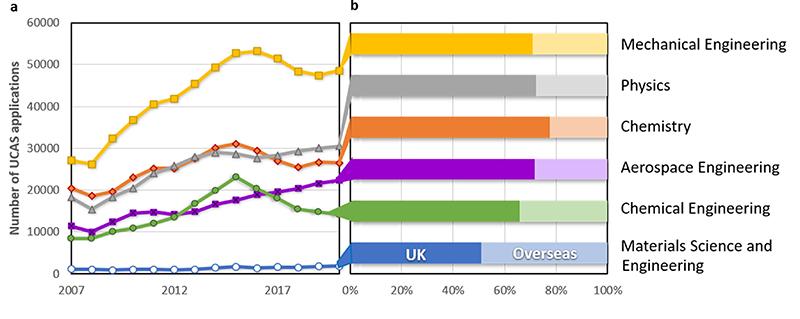
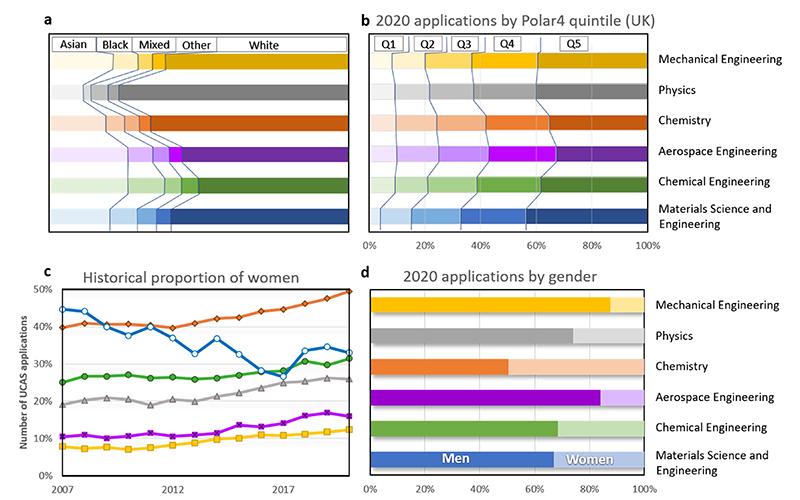
Application conversion
Finally, we explore how conversion rates of typical applicants to MSE differ from that of applicants to other disciplines for the three main stages of the UCAS application cycle: (i) the offering of a (conditional) place to study at university, (ii) conversion of conditional places into acceptances once high-school results are released, and (iii) applicants joining the chosen HE institution.
Looking at the ratio of the total number of offers compared to the number of applications, MSE is comparable to the other disciplines, i.e. MSE applicants’ profiles compared to offer-making criteria are in line with other disciplines.
Next, we look at the ratio of the total number of acceptances relative to offers made, where we find MSE is an outlier compared to other subjects. This either means that we have a pool of applicants that does better relative to the acceptance criteria, or that institutions are more flexible when accepting candidates into MSE programmes.
The last conversion ratio is the total number of students registered to the number of acceptances. The Higher Education Statistics Agency (HESA) publishes data on year 1 students in HE institutions disaggregated by subject, also using JACS. Unfortunately, they adopt a different approach in counting people. For students registered on programmes linked to more than one JACS code,
they assign a Full Person Equivalent (FPE) portion to each JACS code. This means that students:acceptances ratios are generally above 100%, as the UCAS data will undercount the number of acceptances. Given this issue, it is not surprising that this conversion rate for Mechanical Engineering stands at 125% – courses that combine Mechanical Engineering with a specialisation are well known and popular.
MSE, in this respect, is a clear outlier. According to the latest available data, there are almost twice as many registered students as acceptances in the five years to 2018-19. This may be partly due to how UCAS and HESA report their data, but analysis suggests that a significant proportion of students join a MSE programme by internal transfer processes, which matches anecdotal evidence from our interactions with members of the student population.
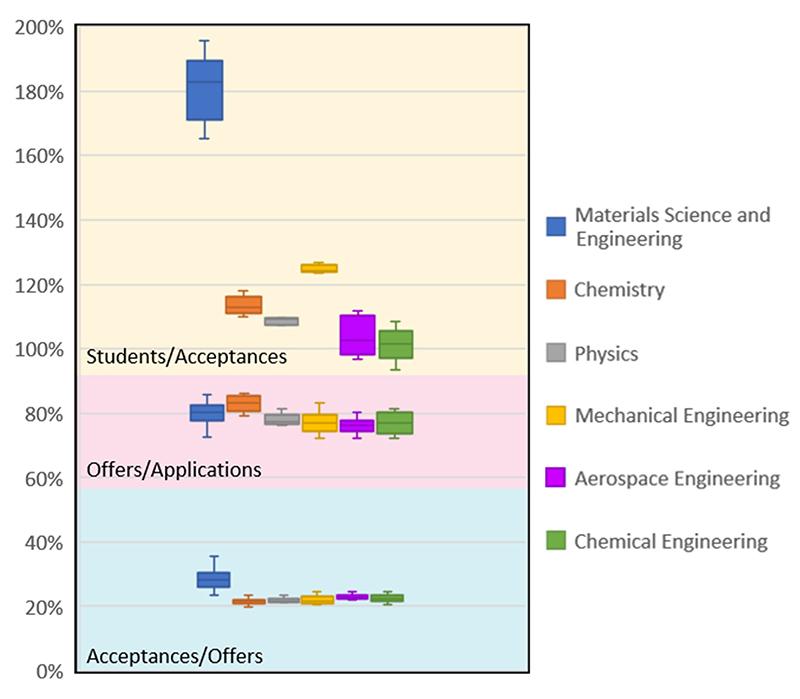
Opportunities ahead
All the evidence suggests that there is significant space to grow and diversify the uptake of MSE as an undergraduate discipline. This conclusion is strengthened when looking at the output from our programmes.
The proportion of students progressing onto graduate employment, and their average salaries, are no different compared to related disciplines. Anecdotal evidence of struggles in recruiting home-educated PhD students in MSE reinforces this. When considering the pathways through MSE, we believe the community would benefit from growth in the pool of students progressing and planning to progress from Key Stage 5 to a MSE HE programme, alongside a reduction in our reliance on later transfers from other disciplines.
Swift action is required. If we do not have a diverse range of excited MSE students at university, it is unlikely we will deliver and realise new materials insight from within industry and academia to support the evolving needs of society.
Discover Materials is a partnership between UK Universities’ Materials Science and Engineering Departments, the Henry Royce Institute and other parties with interests in Materials Science and Engineering. To find out more, visit: www.discovermaterials.uk. For additional analysis on the study presented here.
